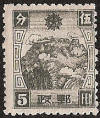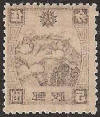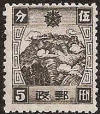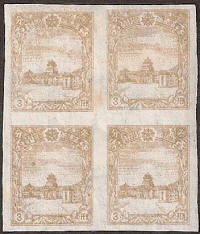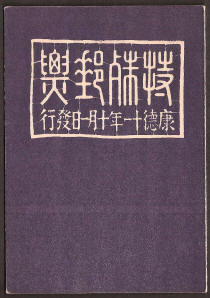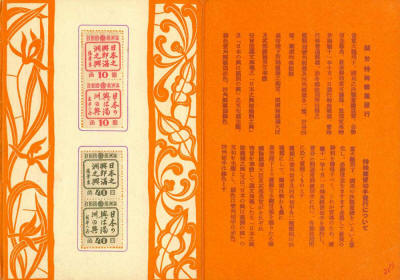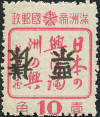 |
||||||
|
|
||||||
|
Postage Stamps Manchukuo Year 11 康德 Kāngdé Fifth Regular Issue These stamps were printed for general use from June 1944. The stamps are re-issues of previous designs based on Zhǎngbáishān and the Heavenly Lake (Baitoushan) from the 1935 Special China Mail stamps and designs taken from the 1936 fourth Regular Issue. These stamps are of poor quality, cheaply produced and often badly perforated and with significant shade variations due to problems with machinery and unskilled staff. Most of the stamps in this issue were released in June of 1944, the 1Y was released later, in November 1944 and the 30f did not appear until 15th February 1945. On this occasion they are litho printed on watermarked (see below) white paper in sheets of 100 by the Manchukuo Government Printing Office, Hsinking. Genuine proofs exist of the 5f in magenta, imperf on un-watermarked paper. Other imperforated 5f stamps in black are often described as proofs but are more likely to be from stock sheets awaiting perforation when looted by advancing Red Chinese and Russian forces. Any "specimen" stamps or sheets you may see for this issue are fakes. The reason that the number of 10f blue stamps is known is because it had only one printing. This stamp was only available through a handful of Post Offices and used examples are very hard to find. It is difficult to make a up complete set in used condition as shown below. Designs by Mr Hirozo Oya. The stamps are 18.5mm x 22mm, Perf 13 x13˝.
Designs in this issue the 5f 長白山 Zhǎngbáishān (Mount Changbai), the birthplace of the Manchu dynasty, plus the 6f, 10f, 20f, 30f and 1y of the 1936 fourth Regular Issue Stamps. |
||||||
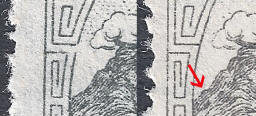 |
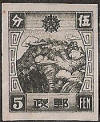 |
|||||
|
11/6/1944 |
Detail showing the distinct types i and ii. Notice the extra ridge, these two types appear on each sheet (including imperf sheets). | imperf | ||||
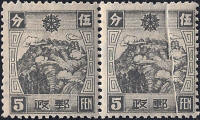 |
||||||
|
Mirror Offset (print on gum) |
Printing Flaw (caused by creasing) | |||||
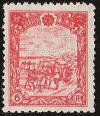 |
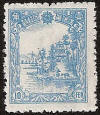 |
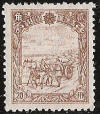 |
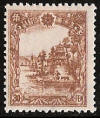 |
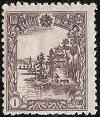 |
||
| 26/6/1944 | 10/6/1944 5,500,000 |
18/6/1944 |
15/2/1945 | 7/11/1944 | ||
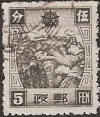 |
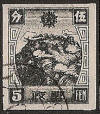 |
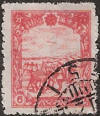 |
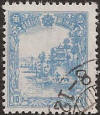 |
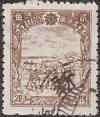 |
||
| Used | Used imperf | Used | Used | Used | ||
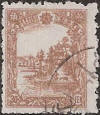 |
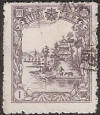 |
|||||
| Used | Used | |||||
|
|
|
|||||
|
|
||||||
| Unissued 3 fen - Proof or Forgery? | ||||||
|
Stamps like those shown below appeared in America at the end of the war and were at first taken for an un-issued value or a proof. Later it was decided that the stamps were forgeries printed on watermarked paper looted from the Manchukuo Postal Bureau in Hsinking as the war ended (see Zirkle page 86). The reasons given for the suspected forgery are as follows;
It should be noted that some well established dealers such as Stanley Gibbons refer to them as doubtful, they also make similar claims regarding the imperf 5f. Whatever the truth of the matter, copies of the unissued 3f are very hard to find and command high prices. |
||||||
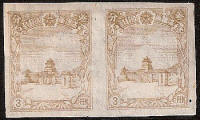 |
||||||
| Imperf proof of the un-issued 3f stamp or a famous forgery? | ||||||
|
|
||||||
|
Friendship with Japan 1st - 9th October 1944. This issue promotes the friendship between the peoples of Japan and Manchukuo. The 10f stamps appeared on 1st October 1944 and the 40f were issued on 9th October 1944, you cannot therefore have a first day cover showing both stamps. From 1st October 1944 10f was the basic letter rate to Japan, Korea, China and the KLT, the 40f stamp was needed because to send these letters registered cost an extra 30f. The stamps were lithograph printed on watermarked (see below) "granite" paper in sheets of 100 by the Manchukuo Government Printing Office, Hsinking. Design by Mr Hirozo Oya. The stamps are 18mm x 21.5mm. Perf 13 x 13˝. Imperf versions exist, possibly as a result of theft from the printers. The ragged and irregular perforation is due to a deterioration in equipment and a lack of skilled workers as a result of the war. The final Manchukuo presentation booklet was produced for this issue (see below). Any "specimen" stamps or sheets you may see for this issue are fakes.
This is a set of 4 stamps with the inscription "Japan's prosperity means Manchuria's prosperity" the values 10f and 40f are repeated with the both stamps being issues in the characters of each language, Chinese and Japanese. The Chinese version is thought to be in the calligraphy of the Manchukuo Prime Minister Chang Ching-hui (Zhang Jinghui), while the Japanese version is by Takebe Rokuzō the Japanese head of the Board of Manchukuo Affairs, and the top Japanese official in Manchukuo. Prime Minister Chang Ching-hui took office in on 21st May 1935 and served until 15th August 1945, he was captured by the Soviet Forces and imprisoned until his death sometime in 1958. In her book Zirkle describes Chang Ching-hui as ex-prime minister at the time this stamp was issued - this in incorrect. Helen Zirkle suggests that at least 10,000,000 of each of the 10f were printed as this was the amount of the initial order. |
||||||
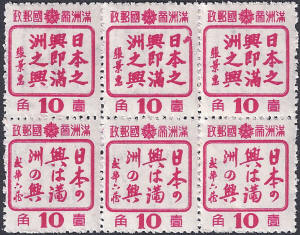 |
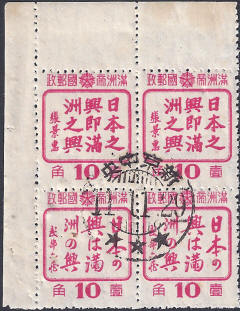
|
|||||
| Block of 6 with an error top middle. | Block of 4 Cancelled to Order, Hsinking. | |||||
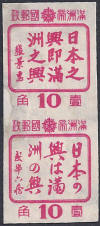 |
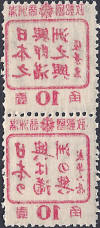 |
|||||
| Imperf | Mirror Offset | |||||
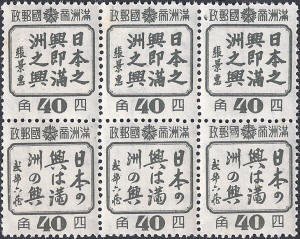 |
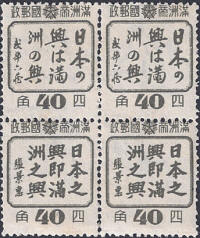 |
|||||
| Block of 6 | Famous rounded corner variety bottom right. | |||||
|
To see a range of errors, flaws and varieties - click here |
||||||
|
Special Presentation Booklet Fake 样票 Specimen stamp offered on eBay.
|
||||||


